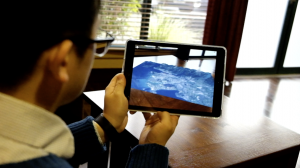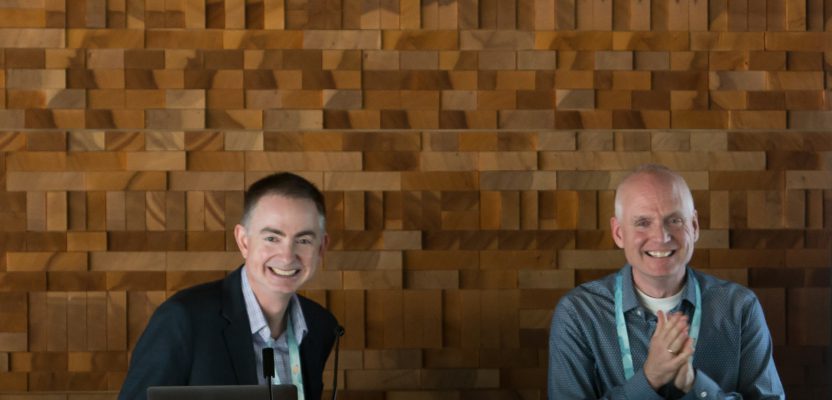A Canadian software company is making it easy for the geospatial community (and beyond) to work with, exchange, and extract value from data.
Many GIS professionals—and others in the geospatial community and beyond—use Safe Software’s FME daily to convert, extract, and analyze data. Yet, few of them know much, if anything, about the Canadian company that created the program and constantly updates it.
Co-founded and co-led by computer scientists Don Murray and Dale Lutz, the company has grown over the past 25 years from that dynamic duo to a staff of about 150 people, mostly young, who speak 15 languages total.
Origins
Murray and Lutz earned their bachelor’s and master’s degrees in computer science. They met when they both worked on a project to build a big data analytical engine at MacDonald, Dettwiler and Associates (MDA), a Canadian company that makes space, defense, and maritime systems.
Murray then left MDA to teach at the British Columbia Institute of Technology, but he and Lutz kept in touch. Eventually, they bid together on a government contract.
“Safe was born with the successful bid of this contract,” Murray recalls.
In the early 1990s in British Columbia, a province as large as Texas and Oregon combined, The Canadian government was trying to keep track of logging by private companies and needed to exchange information with them. However, those companies used different software packages, and the government did not want to mandate that they all use software from the same vendor.
Instead, it was going to invent its own format and then have translators written from it to the commercial packages in use. Murray and Lutz won the contract related to the early work on that project.

Safe Software staff at an FME users conference.
“The format that the government invented was called SAIF,” Murray says. “We made a joke on that when we named the company Safe and got the domain name safe.com, not realizing that 25 years later we would be in business, having almost nothing to do with forestry.”
Lutz adds, “Right from the start, we focused on pretty much what we do now: making it easy for customers to work with, exchange, and extract value from their data.”
The company’s early market was moving data from CAD to GIS, Lutz recalls, because in British Columbia a lot of the mapping was being done with CAD packages.
“The other lucky break for us was that we ended up getting tangled in with Esri’s SDE very close to its beginning. People wanted to move CAD data into the Esri spatial database engine. It turns out that we had a great solution. We got a lot of big projects with telecoms and utility companies. We learned a lot from those and got better and better at moving data from CAD to GIS. Databases crept in. Pretty soon we were doing database stuff, then, mastery stuff.”
Then came lidar data and point cloud, Murray adds. Eventually, they also added Excel, which is now the company’s number-two format in FME. Excel is used so heavily that Lutz calls it “the shapefile of non-spatial data.”
Murray points out that, “the importance of data to all industries continues to grow, to the point that now companies have more data than they know what to do with.”
Collecting data in a database provides no value if it is not used. “At Safe, we say that you are only getting value out of your data when it is actually moving or growing.”
The company is now going after new industries and data sources, such as healthcare and MRI scans. “Our core has no idea what type of data it is working on. It just knows it is data.”
“Our product has the advantage of being non-invasive,” says Lutz. “We don’t require our end users to change their daily work habits.” A future market that the company is pursuing is moving data into GIS from building information models, which are in some ways the successors of CAD. “There is a lot of interest in indoor mapping, putting the blue dot inside the building. Once you’re doing that, it’s not a big step to begin moving that data into augmented reality and virtual reality.”
Markets
The company has penetrated many markets, according to Murray. Currently, its biggest sector is national, state, and local government and the next biggest is utilities, such as oil and gas companies and telecommunication companies.
“We are starting to see some penetration on the indoor side,” says Murray. “There are probably 20 industries that we’re into. We are also seeing more and more companies that do not have spatial data or started with our stuff in spatial and now are using it in other ways. So, non-spatial is a big area of growth and we are excited about it.”
Competitors
Safe’s biggest competitors, Lutz argues, are programmers who want to write code from scratch within their companies due to a “not invented here” syndrome.
“We’re just a tool that can do a lot of things that people would otherwise write Python scripts or C++ code to do. It would take them more time if they did because it causes their companies to have more maintenance burden long-term. We add a lot of value on top of the stuff that we put together so that it is worthwhile to use our stuff instead of writing code from scratch.”
Open source would be a competitor, Lutz notes, but it is also a friend because his company funds a lot of it. Its product, it believes, must add value on top of open source. “If open source is better, then we have failed in some way because we have not added value.”
Additionally, Safe has a lot of respect for a few products, such as Alteryx, that he considers “adjacent” to it and occasionally overlapping with it. “In terms of distinguishing ourselves, I would say that we are trying to provide more value, both by having incredible functionality and incredible ease of use and a great price point.”
Partners
Safe, Lutz says, is aligned with all the major players in the GIS, BIM, and CAD industries. “People like Esri are long-time friends of ours. They have the ArcGIS Data Interoperability extension that is our FME desktop product rebranded.” Murray ads to the list MapInfo, Pitney Bowes, Autodesk, and Bentley. “We’ve had alliances with them and many, many more for a long, long time.”
The company, he says, has about 80 business partners around the world, including con terra in Germany, Sweco in Sweden, 1Spatial, and Miso.
A key to the company’s success is its ability to find these partners, Lutz explains. “We don’t sell directly into those markets. We leave it to our partners. Then Sonia Hobbs, our VP of Business Development and Strategy, has been great to replicate that and tell our partners what it takes to be a good partner.”
Partnering also works extremely well as the company moves into new industries, he points out, because it finds partners there. “The partners also provide services. Safe does not provide services at all, which is different from many companies. That really means that we don’t end up competing with our partners on many of these things.”
“Our job at Safe,” Murray says, “is to make the most excellent product we can, with the best support, and our partners will add value on top of that, by providing training and services around that product. That seems to have worked extremely well. In North America, we do sell direct, but we also have partners that do all the services. Outside of North America, we do not really sell directly and, of course, the services work is done by our partners.”
Challenges
Safe sometimes uses the phrase “freeing the data” to describe its mission. “It really means that people are free to do whatever they want with the data,” Murray says. “So, when you are working with a data set, we try to take away your worries about the format or what system it comes from, just enabling you, as the user who wants to work with that data, to very easily connect to it or read it so that you can extract value out of it.”
He acknowledges that this involves a few challenges. The first one is to understand at the syntactic level about 400 different systems so as to make it easy for users who are not computer scientists to connect to that data and read it.
The second challenge is to build transformers that enable users to use that data—such as raster or point clouds—to solve their specific problems. In the future, Murray predicts, the company will develop video processing transformers.
“Whenever we move to a new area, we identify the sources or the formats or systems that we need to connect to and then we work to identify the major operations that users want to work on with that data.”

According to Lutz, augmented reality and virtual reality are not a big step from indoor mapping.
A third challenge, Lutz points out, is the constant change in the formats that Safe supports. “Our goal is to insulate our customers as much as possible from that change, which means that we must be modernizing and updating our product. If we support 400 formats, every year 50 to 100 of them change, so we have this burden to keep evolving and changing.”
Additionally, nowadays that data often lives behind a variety of Web services—from storage services, such as Amazon S3, Dropbox, or Google Drive, to systems such as Salesforce, NetSuite, or Trello. Therefore, Safe is “looking to ensure that FME can reach out into those Web services, grab the data that is needed, and then push it back in where it needs to be.”
One way it is doing this is via what it calls FME Hub, which enables partners and users to contribute to solutions to access these data.
Culture
A recent company values document lists the importance of team first, followed by a balanced life. “We try to keep people to 40 hours per week,” says Lutz, “and then get the heck out of here. We really want to have fun. While we take our work very seriously and we do important things, we also don’t want to get too full of ourselves and we like to have a little smile now and again. Some of our neighbors in our office building have actually come in and told us ‘There’s too much laughing in here! We’re trying to work.’”
Another key company value is learning. Lutz quotes his personal hero, Wayne Gretzky: “We go to where the puck is going to be, not to where it has been.”
Murray points out that, unlike most software companies, Safe, like restaurants, believes that service and helping customers is just as valuable as the tool. “We really look after our values, to help people make a difference, then the profits just take care of themselves. We could charge more for our product, but we are buying a lot of loyalty with our base, then we just see the profits grow.”

Staff enjoy a relaxed work atmosphere.
Staff
Murray attributes the company’s cultural diversity in large part to the fact that it is based in the Vancouver, BC, area. “If you walk down our hall, it is like the United Nations. We have people from Japan, China, Taiwan, Cambodia, Australia, the Middle East, Europe, a few people from the UK. Those people from the UK are probably the weirdest ones—no! So, it is a great group, from all walks of life.”
He and Lutz are in their early 50s, but the average age of their staff is closer to 30. “Our new hires, primarily, are fresh out of university, with lots of energy.”
Between a third and a half of the staff have a technical background, including programmers and experts in GIS and, more generally, data exchange and software configuration. Another large group works on marketing.
“We have a shockingly small number of admin staff,” says Lutz. “A lot of our business is highly automated.”
When he and Lutz started Safe, Murray explains, it was technology-heavy. “In the early days, that was fine, because a large part was just building up our vision.” Later, they added staff to handle accounting, marketing, business, and relations with partners.
“Probably a lesson we learned is that we should have hired those different skills sooner than we did. We now have a great leader on the partner side, Sonia, who is taking over more and more with her business partner there, Craig Vernon, our VP of customer experience and sales.”
Lutz describes the company as “relatively non-hierarchical” and his partnership with Murray as “tight.” Under them is a large layer of senior people whom they drafted. The technical side, which handles development, is divided into the cloud, server, and desktop/engine teams. The Experts team, consisting of subject matter experts in GIS and other areas, is sub-divided by vertical. The marketing group is sub-divided into operations and those who create the company’s public personas.
Other groups include customer engagement, finance, facilities, development operations, events (which is large), and direct sales (which consists of only half a dozen people).
“Then we have partners around the world,” Lutz points out. “None of our partners are exclusive to a region, because our tools span many, many industries, so partners are often very strong in one particular industry. This enables us to grow into new industries, find those good partners, and grow them into new industries.”
One may wonder what Murray and Lutz would do if they were ever unable to resolve a fundamental disagreement. Toss a coin? “We always try to see each other’s viewpoint,” says Murray. Like in any kind of relationship, he explains, they do not agree on 100% of things.
“However, as long as you believe, in your heart, that the other person is rowing in the same direction, then things are good. We’ve never had anything that was a showstopper. We always joke that if there were one of those, we would go play a game of foosball and the winner would take all, but it has never come to that.”

